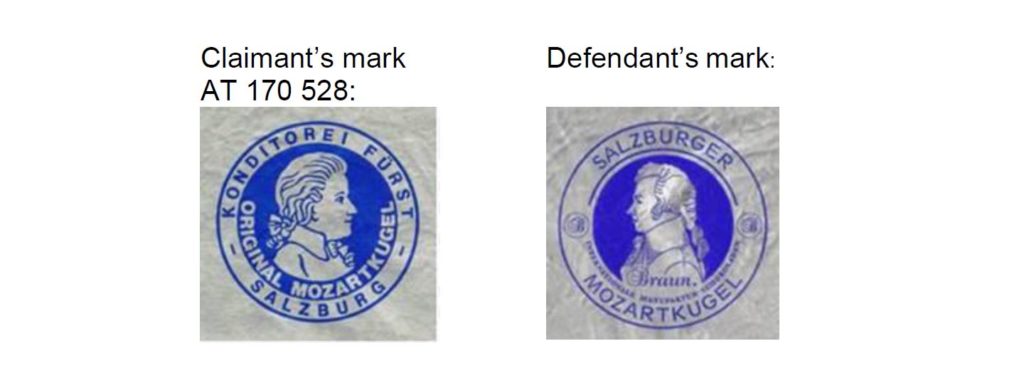On imitation marketing and locally limited likelihood of confusion between the product get-up of “Mozartkugel” confectionery.
The city of Salzburg is not only the birthplace of Wolfgang Amadeus Mozart, but also home to one of Austria’s most famous sweets, the „(Salzburger) Mozartkugeln”. The Austrian Supreme Court (“OGH”) recently decided in a conflict between two Austrian producers of such sweets (case ref. 4 Ob152/17g, decision of 21.11.2017).
“Mozartkugel” has become generic for ball-shaped sweets with a chocolate cover and there are many variants on the market. However, only the Salzburg-based confectionery house Fürst, which relies on a recipe from 1890, may call its product the “Original Salzburg(er) Mozartkugel”. Fürst uses a signature silver tinfoil packaging with blue print on it, and registered this as a trademark for chocolate products and confectionery – as shown below.
Fürst sued its competitor, Braun, after Braun had changed its initial brown product packaging to a look-alike silver-tinfoil packaging as shown below, and sold it in an outlet close to one of Fürst’s four Salzburg outlets:
In addition, Braun’s Mozartkugeln did not originate from Salzburg, as the wording “SALZBURGER MOZARTKUGEL” on the packaging indicates, but were produced by a third party in the Austrian province of Upper Austria.
Fürst claimed that the use of Braun’s packaging leads to a likelihood of confusion with Fürst’s packaging and therefore constitutes unlawful imitation marketing (§ 2 Abs 3 Z 1 UWG which transposes Art 6 (2) (a) of the Unfair Commercial Practices Directive).
The lower Courts and the OGH agreed with Fürst. They found that the packaging of the two Mozartkugel products rendered a similar overall impression due to their (similar) material, shape and colour, and would thus confuse the relevant public. The device elements were more decisive for a finding of similarity than the – existing – differences between the word elements. Nor did it help Braun that its packaging comprised a figurative trademark consisting of its name and the wording “International Manufactured-Chocolates” mark, as depicted below.
Braun was ordered to cease offering its sign (i.e. the packaging) for chocolate and confectionery in the city of Salzburg. A nationwide injunction was only granted to prohibit Braun’s offering of “Salzburger Mozartkugeln” that do not originate from Salzburg.
The locally limited prohibition was prompted by Fürst’s packaging only enjoying a local reputation in the city of Salzburg. Moreover, the Austrian case law on imitation marketing (which is an unfair competition concept, not one of trademark law) requires “actual confusion”: Only if the original product is actually known by a relevant part of the public, it will be associated with a specific producer, leading to confusion. Product packaging, which is not registered as a trademark, must have acquired distinctiveness to enjoy protection (4Ob227/12d – Tico Pop Lutscher). One wonders, however, if the OGH also wanted to transport those concepts of local limitation into trademark law.
The OGH mentions Fürst’s trademarks for its packaging, and that they enjoy protection already through registration, but then confirms that the (local) reputation, as ascertained by the lower instances, in any event constitutes acquired distinctiveness – limited, however, to Salzburg.
Notably, on appeal the OGH only checks whether the legal reasoning of the lower courts is sound and arguable, but not whether it is actually correct.
The discussion is reminiscent of the situation in an EU context where an EUTM that only has a reputation in a specific place in the EU cannot rely on this reputation in another place where the consumers are not even familiar with the mark (Case C-125/14, Iron & Smith kft v. Unilever NV – see related blog post here). On the other hand, the Austrian trademark law does not provide for geographical limitations to the protection of registered Austrian marks (and the same appears to be true for national trademark laws of other EU Member States).
_____________________________
To make sure you do not miss out on regular updates from the Kluwer Trademark Blog, please subscribe here.
Kluwer IP Law
The 2022 Future Ready Lawyer survey showed that 79% of lawyers think that the importance of legal technology will increase for next year. With Kluwer IP Law you can navigate the increasingly global practice of IP law with specialized, local and cross-border information and tools from every preferred location. Are you, as an IP professional, ready for the future?
Learn how Kluwer IP Law can support you.




